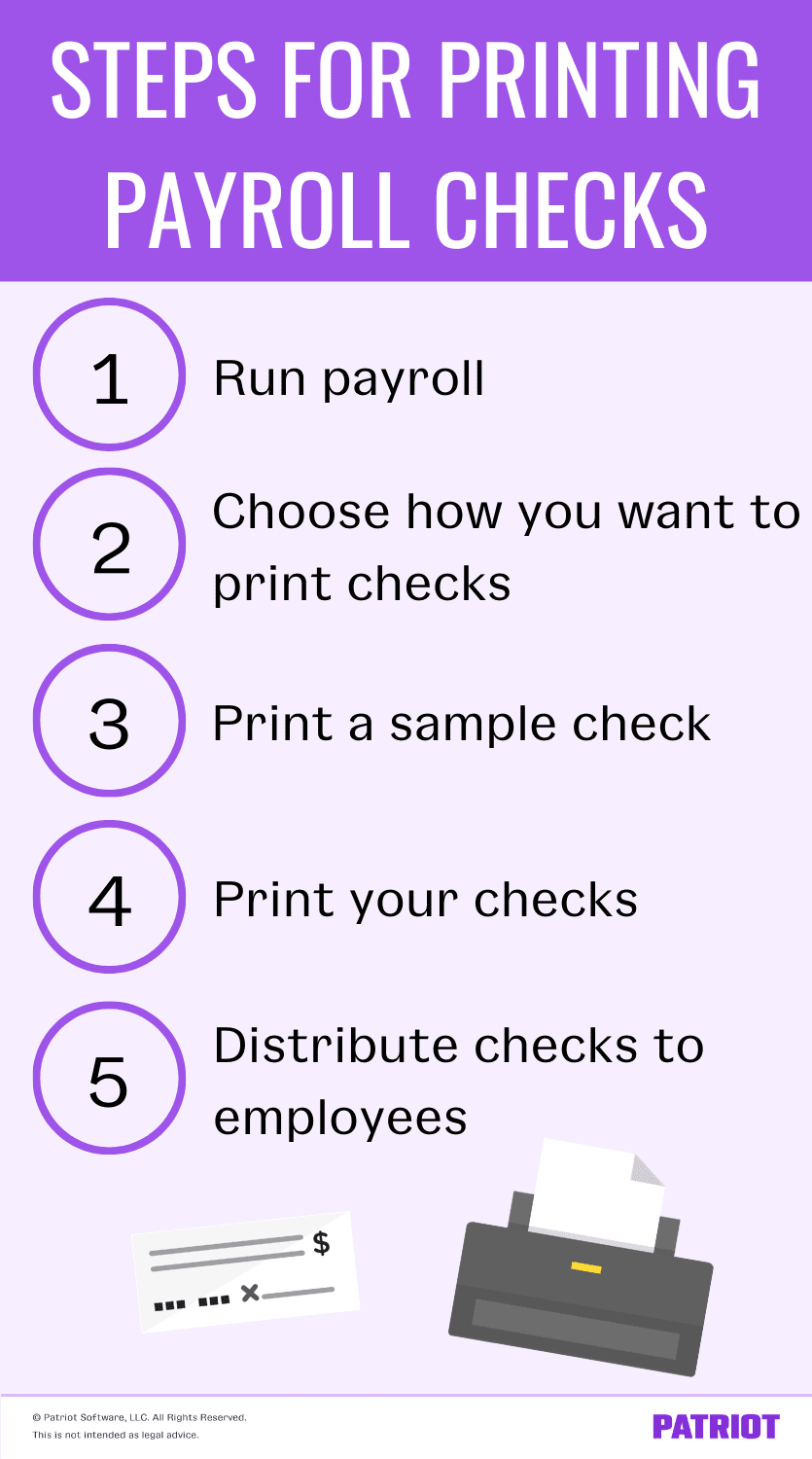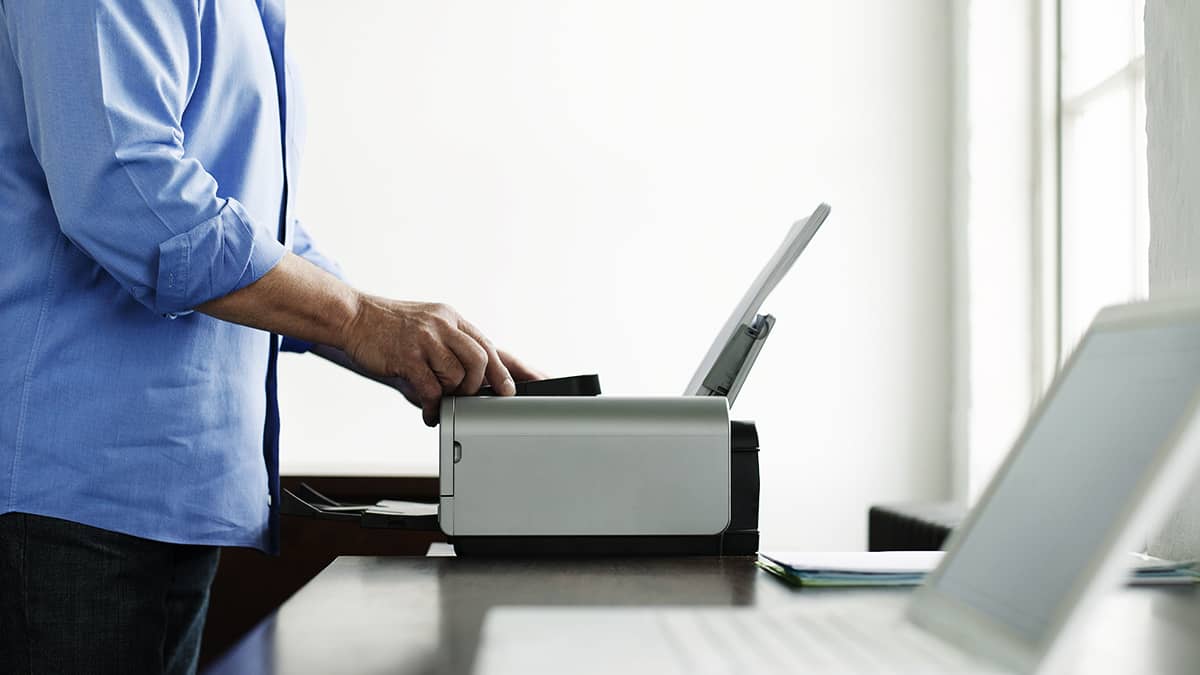As an employer, you have different options to choose from when it comes to paying employees. One option you have is to print payroll checks. Printing checks comes with a few decisions, like purchasing supplies and selecting a check layout. Learn what steps you need to take to get your employees’ wages from computer to paper.
Before you print payroll checks…
Hold it right there, employers. Before you can even begin to learn all about how to print payroll checks, you need to gather a few things. To be more specific, you must gather a few supplies.
To print payroll checks, you need to have the following handy:
- Software to print from
- Payroll software
- Check printing template or software
- Check stock
- Blank
- Preprinted
- MICR (magnetic) ink
- Printer
- Envelopes, if applicable
Software
To print checks for your employees, you need a software or template to print from.
Many employers opt to use payroll software to print their checks. After you get your payroll software up and running, you can print your payroll checks directly in your account. Within your software account, you can choose check printing settings and adjust the layout.
Some employers may have a different way to run payroll (e.g., manually or through an accountant). If you don’t use software for payroll, you can set up an account with a separate check printing software or use a template online.
| Interested in getting payroll software but not sure what it’s going to cost you? Download our FREE guide (yes, we said free), “How Much Does Online Payroll Software Cost?“ |
Check stock
When it comes to check stock, you can either get preprinted or blank stock. You can purchase check stock through your bank, online through a vendor, at an office supply store, and sometimes through your payroll provider.
Preprinted check stock has your business’s information (e.g., name, address, bank account information, etc.) already on it. However, you still need to print information onto the check, like the employee’s name and net pay amount.
Blank check stock has no information on the check whatsoever. It is completely blank, and it’s up to you to print all of the information onto the check. With blank payroll checks, you also need to use MICR ink…
MICR ink
MICR (magnetic ink character recognition) ink is a special type of ink used to print bank account information onto check stock. You must use MICR ink if you plan on using blank check stock. And, you might consider getting a MICR printer. However, many standard printers are compatible with MICR ink.
Bank check readers are made to read MICR ink on checks. If you use normal ink or toner on a printed check, the employee’s bank may not be able to process the check.
Some banks may still be able to take a check without the MICR ink, but it will likely cost your employee some type of fee for the bank to process the check manually.
Again, you do not need to get MICR ink if you purchase preprinted check stock.
Printer
You don’t need an elaborate or expensive printer to print checks for your employees. Generally, a standard printer works just fine.
If you are using blank check stock, check to make sure that your standard printer can use MICR ink. If your standard printer does not accept MICR ink, you may need to get a MICR printer to print onto blank stock.
Envelopes
If you plan on mailing checks to employees or want to conceal checks for security purposes, purchase envelopes for the checks to go into.
How to print payroll checks
Now onto the part you’ve all been waiting for: how to print payroll checks. Without further ado, here are the five steps to payroll check printing.
1. Run payroll
Before you can print any paychecks, you need to know how much you owe employees. And to know how much you owe employees, you need to run payroll.
By now, you likely know the drill. Calculate the employee’s gross pay, deduct payroll taxes and deductions, and approve payroll. Run your payroll using whatever method you use (e.g., payroll software, by hand, or accountant) to find your employees’ net pay amounts.
2. Choose how you want to print checks in your software
After you find the net pay amount you owe to each employee, select how you want to print the checks in your payroll or check printing software.
Follow these steps to get your checks ready to roll in the software:
- Select the check layout (e.g., check on top)
- Choose the type of check stock (e.g., blank)
- Check printer settings
- Make adjustments to the layout, if necessary
If you’ve already adjusted this setting in your software, you can skip this step and move on to #3.
3. Print a sample check
To ensure that all of your check printing settings are in order, it’s always a good idea to print a sample check.
Print a sample check to make sure everything is aligned correctly on your check stock. If anything doesn’t line up, make adjustments and print another sample check.
4. Print your payroll checks
Once your check printing settings are correct, it’s time to print your paychecks (woohoo!). Make sure your printer has enough check stock to print your employees’ checks and get crackin’.
5. Distribute checks to employees
After you print all of your checks, distribute them to your employees. You may give them to your employees in person or mail them out.
If you plan on mailing checks to employees (e.g., remote or out-of-state workers), place the check in an envelope and send them in the mail.

Pros and cons of printing payroll checks
On the fence about whether printing business checks is the best option for your business? Weigh the pros and cons to help determine if it’s the right route to take.
Here are some pros of printing checks:
- Employees don’t need a bank account to cash checks
- Can save you time from handwriting checks
- Gives employees more privacy and control over their money
Check out a few cons of printing paper checks:
- Costs for purchasing supplies
- Could harm your business if the check gets into the wrong hands (e.g., lost, stolen, etc.)
- Can cost you more time assembling, formatting, and printing checks
Alternatives to printing checks
Of course, printing paychecks isn’t your only option as an employer. You can also:
- Handwrite payroll checks
- Use direct deposit
- Pay employees with cash
- Use mobile wallet
- Give employees pay cards
Before you make a decision on a payment method, weigh the pros and cons to ensure you choose the best option for your business. And, be sure to review and follow state laws. For example, pay card laws vary from state to state.
This article has been updated from its original publication date of January 20, 2017.
This is not intended as legal advice; for more information, please click here.
